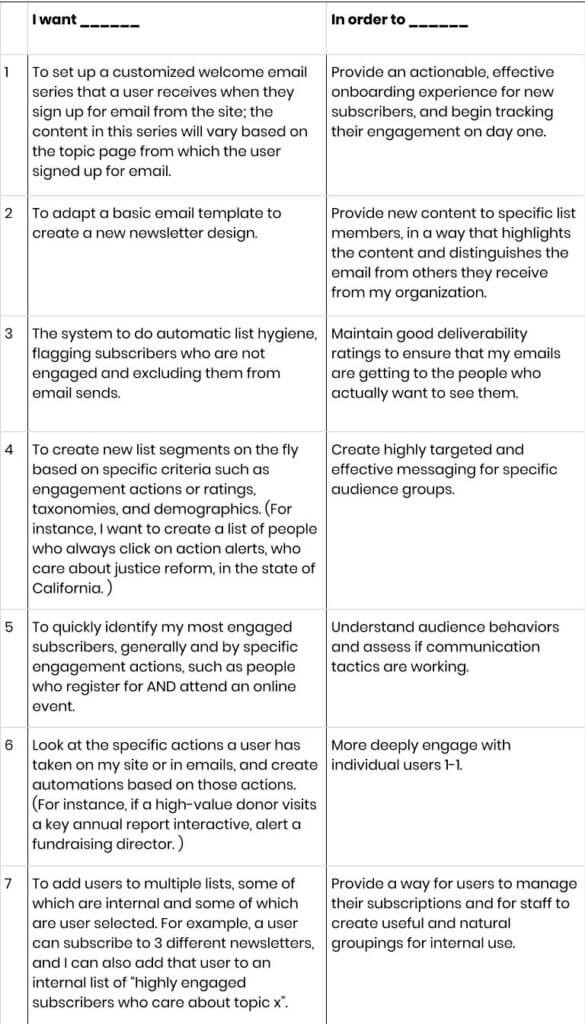Is your organization thinking about changing or upgrading its email management system? If so, we’re delighted that you care so deeply about the effectiveness of your organization’s emails—we can’t emphasize enough the importance of email in deepening engagement among your audiences!
Having advised dozens of mission-driven clients on how to boost their email capabilities, we’ve come to believe there’s no “best” vendor in the marketplace: every group’s needs are unique, and systems have different weaknesses and strengths. Yet we do have strong opinions on the optimal process for identifying requirements and choosing from multiple options.
No matter what part of the mission-driven sector you work in, the most useful piece of advice we can give you is this: invest the lion’s share of your energy into concretely articulating the most important things you want your email system to do.
This sounds like common sense (and it is). Yet there’s a very specific way in which it’s most helpful to structure these requirements: in the form of “use cases”. Use cases are statements that take the following form:
“I want to [do X] in order to [achieve Y].”
Why are use cases so valuable?
Use cases have the benefit of translating your needs into clear statements that both internal stakeholders and outside technical experts can easily understand. Their structure emphasizes the action that your team will take (the “X”), in relation to their business reason for doing it (the “Y”). By embedding the purpose of the desired action within each use case statement, you make it easy for everyone to grasp why a specific functionality is so important to your success.
To develop use cases, you have to get into the weeds and understand the needs of everyone who relies on your current email system:
- How are they using it today?
- What are their biggest time-sucks?
- Which new features would make their jobs easier?
When you initiate an inclusive process, oriented around specific business needs, you dramatically increase the odds of picking a new system that drives improved performance.
In addition, use cases make it far simpler to interview vendors and learn how easily and quickly they can make your dreams come true. Without them, you’re likely to end up with a long list of hypothetical “capabilities” offered by a product manager (often in the form of a checklist). We love checklists as much as anyone. But they usually don’t give you specifics on how much internal staff time or external development will be required to actually implement the features you want. It’s essential to know this before choosing an email system.
Examples of use cases for email systems
Below we’ve offered a list of common use cases for new email systems. Your organization likely will have additional ones that are tailored to your specific mission and work.
![]()

![]()
It’s extremely important that your email system allows staff members to implement these actions themselves, without the need for ongoing support from custom developers or outside consultants.
You’re looking for the “best-fit” solution, not necessarily the biggest, most complex software
Most likely, the process of developing use cases will help you realize that you don’t need (or perhaps even want) a system that does everything under the sun. Rather, there will be a handful of use cases that matter to you above all else – specific actions you’ll take every day or week that will deeply influence your team’s effectiveness. If your new system can do these seamlessly, you’ll have very happy staff members on your hands!
Transitioning to a new EMS isn’t painless (but you already knew that)
Taking the time to plan a transition to a new email system is not – or at least shouldn’t be – an instant process. After developing your list of use cases and turning them into technical requirements, you’ll interview vendors and assess their relative merits. This information will inform a final selection of an email solution that meets as many of your organization’s needs as possible. After making this final call, you’ll need to plan a careful transition from your current system to the new one. Any competent vendor will be able to walk you through the ins and outs of making this happen.
It takes sustained attention to detail to get a new solution that actually delivers on its promise. Yet when it comes to email, we’ve found that this upfront investment of effort is almost always worth it. Fortunately, we are here to help! Please feel free to schedule an appointment with us if you’d like an informed, objective lens on how to identify the right email system for your organization.





